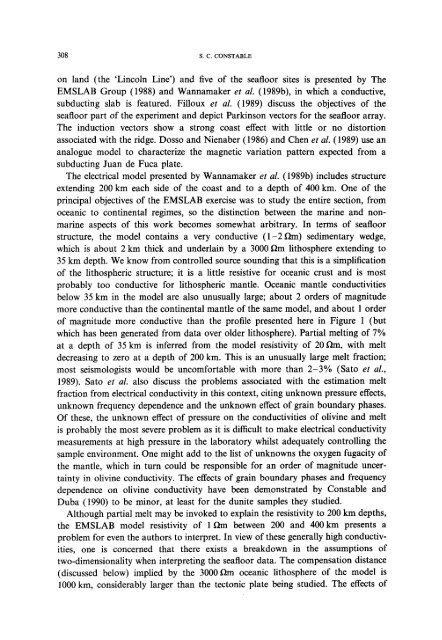Marine electromagnetic induction studies - Marine EM Laboratory
Marine electromagnetic induction studies - Marine EM Laboratory
Marine electromagnetic induction studies - Marine EM Laboratory
Create successful ePaper yourself
Turn your PDF publications into a flip-book with our unique Google optimized e-Paper software.
308 S.C. CONSTABLE<br />
on land (the 'Lincoln Line') and five of the seafloor sites is presented by The<br />
<strong>EM</strong>SLAB Group (1988) and Wannamaker et al. (1989b), in which a conductive,<br />
subducting slab is featured. Filloux et al. (1989) discuss the objectives of the<br />
seafloor part of the experiment and depict Parkinson vectors for the seafloor array.<br />
The <strong>induction</strong> vectors show a strong coast effect with little or no distortion<br />
associated with the ridge. Dosso and Nienaber (1986) and Chen et al. (1989) use an<br />
analogue model to characterize the magnetic variation pattern expected from a<br />
subducting Juan de Fuca plate.<br />
The electrical model presented by Wannamaker et al. (1989b) includes structure<br />
extending 200 km each side of the coast and to a depth of 400 km. One of the<br />
principal objectives of the <strong>EM</strong>SLAB exercise was to study the entire section, from<br />
oceanic to continental regimes, so the distinction between the marine and non-<br />
marine aspects of this work becomes somewhat arbitrary. In terms of seafloor<br />
structure, the model contains a very conductive (1-2 f~m) sedimentary wedge,<br />
which is about 2 km thick and underlain by a 3000 ~)m lithosphere extending to<br />
35 km depth. We know from controlled source sounding that this is a simplification<br />
of the lithospheric structure; it is a little resistive for oceanic crust and is most<br />
probably too conductive for lithospheric mantle. Oceanic mantle conductivities<br />
below 35 km in the model are also unusually large; about 2 orders of magnitude<br />
more conductive than the continental mantle of the same model, and about 1 order<br />
of magnitude more conductive than the profile presented here in Figure 1 (but<br />
which has been generated from data over older lithosphere). Partial melting of 7%<br />
at a depth of 35 km is inferred from the model resistivity of 20 f~m, with melt<br />
decreasing to zero at a depth of 200 km. This is an unusually large melt fraction;<br />
most seismologists would be uncomfortable with more than 2-3% (Sato et al.,<br />
1989). Sato et al. also discuss the problems associated with the estimation melt<br />
fraction from electrical conductivity in this context, citing unknown pressure effects,<br />
unknown frequency dependence and the unknown effect of grain boundary phases.<br />
Of these, the unknown effect of pressure on the conductivities of olivine and melt<br />
is probably the most severe problem as it is difficult to make electrical conductivity<br />
measurements at high pressure in the laboratory whilst adequately controlling the<br />
sample environment. One might add to the list of unknowns the oxygen fugacity of<br />
the mantle, which in turn could be responsible for an order of magnitude uncer-<br />
tainty in olivine conductivity. The effects of grain boundary phases and frequency<br />
dependence on olivine conductivity have been demonstrated by Constable and<br />
Duba (1990) to be minor, at least for the dunite samples they studied.<br />
Although partial melt may be invoked to explain the resistivity to 200 km depths,<br />
the <strong>EM</strong>SLAB model resistivity of 1 ~m between 200 and 400 km presents a<br />
problem for even the authors to interpret. In view of these generally high conductiv-<br />
ities, one is concerned that there exists a breakdown in the assumptions of<br />
two-dimensionality when interpreting the seafloor data. The compensation distance<br />
(discussed below) implied by the 3000 f~m oceanic lithosphere of the model is<br />
1000 kin, considerably larger than the tectonic plate being studied. The effects of
















